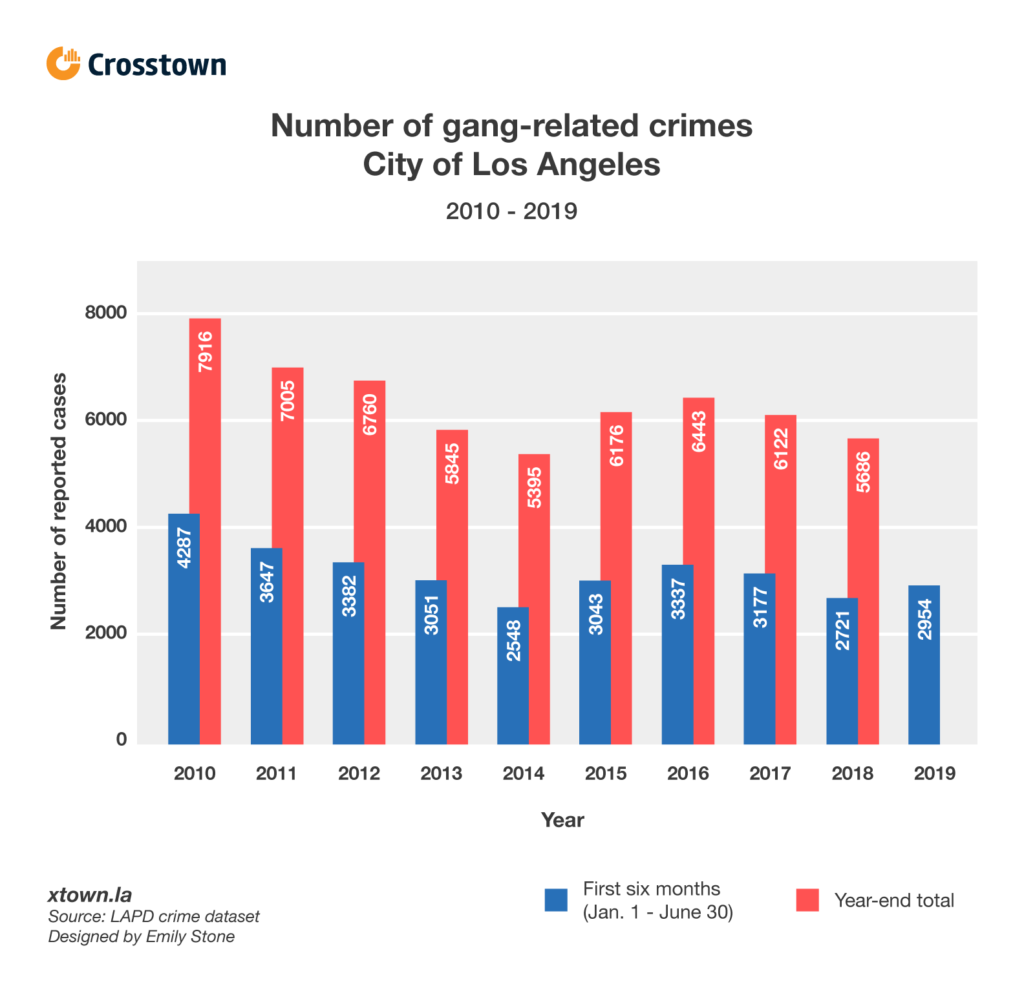Gang-related crimes up in the first six months of 2019

After rapper Nipsey Hussle was gunned down in March, leaders from numerous Los Angeles gangs came together to try to forge a truce.
Despite their efforts, reports of gang-related crimes in the City of Los Angeles rose by nearly 9% during the first half of 2019, compared with the same period last year, according to publicly available LAPD data.
There was an average of 16.3 gang-related crimes per day from Jan. 1 – June 30, 2019, compared to an average of 15 per day for the same time period last year.
Gang-related crimes here have also recently made national news with a sweeping federal indictment last month of 22 alleged MS-13 members in Los Angeles. (These indictments do not show up in LAPD data because they were conducted by federal agents, not city police.)
And yet, despite the recent attention on gangs and the increase in reported crimes in the first half of the year, gang-related crime has actually been on the decline in the city since 2010, the year that the LAPD started making its crime data public.
The average daily number of gang-related crimes in 2018 was 15.5, down 28.2% from the daily average of 21.6 crimes in 2010.

The LAPD credits its own prevention programs for the ongoing decline in gang-related crime. Some of its gang-related initiatives include the Community Safety Operations Center (CSOC) and the Gang Reduction and Youth Development (GRYD) Foundation.
The CSOC, for example, analyzes crime data to make decisions about where to allocate resources, said Officer Hector Diaz, who is part of the LAPD’s Gang and Narcotics Division. And the GRYD Foundation, led by the City of Los Angeles Mayor’s Office, organizes events such as anonymous gun buybacks in an effort to reduce gang violence in the city.
“Peace talks probably aren’t going to change things, you know,” said Diaz. “These have happened before, and cease fires are often temporary.”
But Alex Alonso, a gang researcher who runs streetgangs.com — a website aggregating gang and law enforcement news — and teaches Chicano and Latino Studies at California State University, Long Beach, said gang reduction follows a bigger trend in overall crime declining since the violent 1990s.
“All crimes, particularly violent crimes in LA, have been on the decline ever since the 1990s, with dramatic decreases from then to the 2010s,” he said. “While I appreciate the efforts, … I can’t see a single program that can lead to this reduction. It is disingenuous for law enforcement to pat themselves on the back when in fact this reduction is due to a combination of a dozen factors.”
Indeed, gang-related crime and other violent crime had been decreasing in the city for decades until a recent uptick of gang-related crimes in 2014.
The LAPD reports 11 categories of gang-related crimes that have declined about 58% overall since 1992 according to the annual gang statistics report published by the department. These 11 crimes include homicide, aggravated assault, attack on police officers and rape.
How we did it: We examined LAPD publicly available data on reports of gang-related crimes for the first half of 2019 as well as all crimes in the database since Jan. 1, 2010, when the data began. For neighborhood boundaries, we rely on the borders defined by the Los Angeles Times. Learn more about our data here.
LAPD data only reflect crimes that are reported to the department, not how many crimes actually occurred. In making our calculations, we rely on the data the LAPD makes publicly available. On occasion, LAPD may update past crime reports with new information, or recategorize past reports. Those revised reports do not always automatically become part of the public database.
Want to know how your neighborhood fares? Or simply just interested in our data? Email us at askus@xtown.la.






